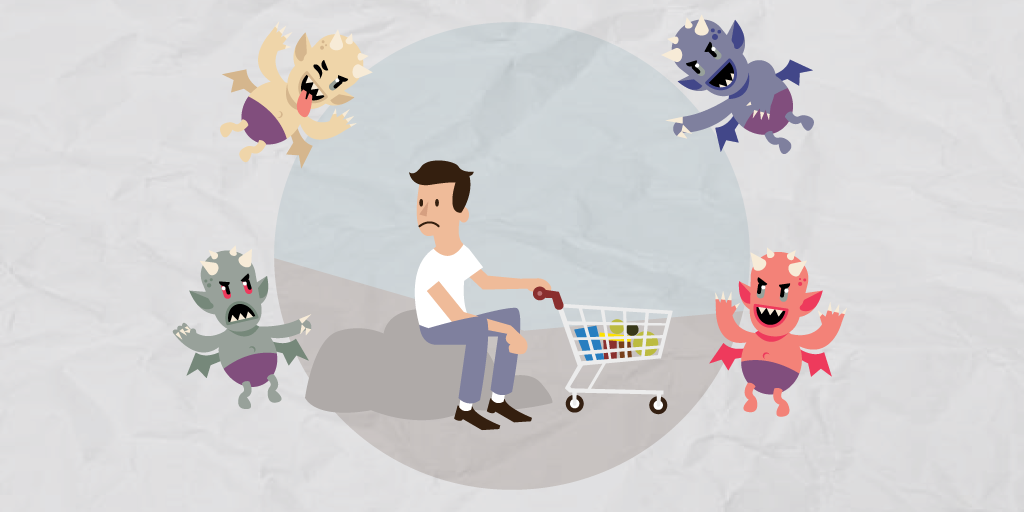If you care about your brand's well-being, then you should care about your customers' satisfaction. The thing is, how do you effectively measure it?
There are a lot of different metrics and methodologies, but which are more reliable? When it comes to customer satisfaction, you want to be able to identify it fast, accurately and consistently.
In this article, we will go over not only different types of customer satisfaction metrics but also the nuances of applying them in your business strategy.
There’s a lot to cover, so here’s a brief look at our customer satisfaction guide. Feel free to click on any of the headings below to jump to the relevant section:
Chapter 1: The Importance of Measuring Customer Satisfaction
Chapter 2: Customer Satisfaction Metrics
Chapter 3: Using Customer Metrics to Drive Growth
The importance of measuring customer satisfaction
Why do you need to measure customer satisfaction?
You are probably familiar with the reasons yourself, so there’s no need to wax poetic about it. Still, it doesn’t hurt to go over it one more time, so we will briefly touch upon the most prominent reasons.
Firstly, measuring customer satisfaction helps you become customer-centric.
Knowing all the how’s and why’s of customer interactions helps you prevent customers from switching to another company — and just one bad customer experience is enough for 58% of customers to switch to another brand.
When you take into account that poor customer service costs $338.5 billion globally each year, customer satisfaction becomes a major player in business success.
Secondly, customer satisfaction metrics allow you to predict future behaviors.
Access to big data is as much about a situation “now” as it is about “then”. By exploring trends and purchase/response history, you can successfully predict future customer behaviors. As a business, service intelligence should be your top priority.
Lastly, measuring customer satisfaction is how you improve your marketing efforts.
The power of knowing what ticks for your customers and what doesn't cannot be understated. Once you know the common issues that your customers run into or what aspects of your business your customers praise the most, you know what to focus on in your marketing.
Of course, this is not a complete list of all the benefits of measuring customer satisfaction — such a list would considerably fatten up this already detailed guide — but you get the picture.
Now, for the main course on our menu — an in-depth guide to customer experience metrics.
Customer satisfaction metrics
Customer satisfaction metrics are numerical scores or indices that summarize data about your customers. In essence, customer metrics indicate the health of your relationship with the customer.
What makes a customer metric useful? There are four pillars on which every effective metric stands.
A customer metric needs to:
Be clearly defined. What does it measure and what it doesn’t? Every metric should center around a specific question which leads to a specific answer.
Have a precise scoring system. When you get a score, you need to be able to tell right away what this score stands for and how it relates to a different score.
Be reliable and verifiable. You need to be sure that metrics are statistically relevant and accurately capture your customers’ feelings. Otherwise, you can’t act on the results.
Reveal useful information. There is no use in metrics which don’t help drive real, measureable changes. The answers of your customers need to be relevant to your brand’s well-being.
Having said that, let’s look at some of the more popular customer satisfaction metrics as well as the advantages and disadvantages of each one.
Customer Satisfaction Score (CSAT)

Customer Satisfaction Score, or CSAT for short, is a widely-employed customer satisfaction metric. CSAT is used to rate the overall satisfaction with the service(s) received by a customer.
Respondents are asked to weigh their satisfaction on a scale from 1 to a predetermined number (usually 3, 5, or 10). Each number corresponds to a specific level of satisfaction, with low numbers indicating low satisfaction and high numbers indicating high satisfaction.
CSAT score can also be expressed on a scale of 0 to 100 percent, where the same principle is applied — the higher the number, the higher your satisfaction.
Sometimes instead of numbers, surveyors use emoticons. This approach helps transcend the language barrier, as the meaning of emojis is explicit and universal — over 92% of online users using emojis in their everyday conversations.
The standard question is “How would you rate your overall satisfaction with the service?” To successfully measure CSAT, this question needs to be measured when a service interaction is still fresh.
Measuring CSAT after every new update helps successfully gauge customers’ satisfaction with the changes. If responses are positive, you’re on the right track. Neutral and below-neutral scores require follow-up action.
You can also edit the question to focus on the product, last interaction, customer journey, service staff, etc. This can help you better identify issues present in your business.
Moreover, CSAT indirectly expresses the level of satisfaction among employees, as these figures tend to correlate.
PROS:
CSAT surveys are easy to implement.
CSAT provides benchmarkable numbers which you can compare to the nation’s average figures.
CONS:
CSAT deals with subjective scoring, “satisfaction” is too simplified of a term.
Neutral and dissatisfied customers don’t always fill out surveys, which skews the results.
There are cultural differences which may influence the scores.
Net Promoter Score (NPS)

Net Promoter Score, or NPS for short, is one of the common ways of measuring customer loyalty. NPS was invented in 2003 by Fred Reichheld , a partner at management consulting company Bain & Co.
Like CSAT, NPS centers around a single question — “How likely are you to recommend the services?” The answer is given on a scale from 1 to 10.
The difference between NPS and CSAT is that it focuses on intention (“I will (not) recommend the services”) rather than emotion (“I am (not) satisfied with the services”).
The question is whether your customers are willing to put their reputation on the line by recommending your product/service.
Based on their scores, customers are sorted into three categories.
Score 9 — 10: Promoters
Score 7 — 8: Passives
Score 0 — 6: Detractors
What do these monikers mean, exactly? Let’s take it from bottom to top.
Detractors are unhappy customers who are likely to spread negative word of mouth and thus damage your company.
Passives are generally satisfied customers whom you failed to fully engage. For now, they are here to stay, but then won’t get hangups about switching to another company.
Lastly, promoters are customers who you should focus on — they keep purchasing from your company and refer your services to others. They are the cornerstone of your business.
Knowing the number of promoters and detractors of your brand, you can calculate NPS using this simple formula:
NPS = % Promoters — % Detractors
NPS correlates strongly with repurchases, referrals and other factors contributing to a company’s growth. The thing is, it’s not a miracle solution by itself, and needs to be used in conjunction with other tools.
Once you get an answer to your NPS survey, you need to follow up with an open-ended question, such as “What changes to our products/services would prompt you to give us a higher rating?”
PROS:
NPS is easy to implement, intuitive, and has high response rates.
NPS provides benchmarkable numbers which you can compare to the scores of other companies in your industry.
NPS promotes word of mouth — by asking a direct question, NPS surveys make your customers think about the possibility of referring your business to others.
CONS:
NPS is not comprehensive enough and may paint an unrealistic picture of your business.
Scoring depends on the cultural mindset of a person — even when fully satisfied, they can rate you lower due to their belief that “there is no such thing as perfection”.
Customer Effort Score (CES)

Customer Effort Score, or CES for short, seeks to understand how much effort a customer needs to exert to have their issue solved.
The idea for CES came from the CEB’s article Stop Trying to Delight Your Customers, published in 2010. The research showed that customers are likelier to punish for bad experiences than to reward for good ones.
For CES to be successful, the question needs to be worded the right way. By asking 50,000 customers from different regions and industries, CED found a question that supposedly 25% more predictive of customer loyalty than the next version:
“To what extent do you agree with the following statement: The company made it easy for me to handle my issue.”
Initially, CES came with a scale of 1 to 5, with “inverted” meanings: 1 meant “good” and 5 meant “bad”. In a revised version, CES goes from 1 (strongly disagree) to 7 (strongly agree).
This new metric proved highly reliable. 96% of customers with high-effort experiences lose their loyalty, compared with 9% customers of low-effort experiences. CEB claims CES predicts customer loyalty 1.8 times better than customer satisfaction scores such as CSAT and NPS.
The idea behind CES is that a company should relieve customer’s pains rather than spoil them with excessive attention.
According to CEB, moving a customer from a score of 1 to 5 boosts their loyalty by 22%. After that, the laf of diminishing returns kicks in, with only a 2% increase in customer loyalty between a score of 5 and 7.
Like with other metrics, the best time to ask a CES question is right after a customer has concluded a CES-specific action. You have probably encountered websites that shoot quick surveys your way after you close a chat window or confirm your order.
PROS:
CES helps better identify the pain points of your customers.
CES has a tangible effect on customer loyalty and satisfaction.
CONS:
Agree/disagree questions are subject to acquiescence response bias — people tend to agree rather than disagree.
Like other scoring systems, CES can become a victim of central tendency bias — people score around the midpoint of the scale to appear more objective and balanced.
Other customer metrics
NPS, CSAT and CES are the most important and widely-used customer experience metrics. There are, of course, other metrics that help you better understand the experiences of your customers.
This includes, for example, Things Gone Wrong (TGW) — a number of reported complaints. To calculate TGW, divide received complaints by the total number of responses, and express the resulting number as “per 100/1000/etc. units”.
There are also metrics related to responses from support, such as Average Handling Time and First Response Time.
Average Handling Time (AHT) measures the total average duration of a single call or ticket. It usually includes hold time, talk time as well as the post-call tasks related to the ticket.
AHT is a decent management tool to help managers calculate their performance and make effective shift and staffing decisions. However, there are arguments against using Average Handling Time, too.
First Response Time (FRT) measures the time taken to respond to a ticket. This does not include the "time to resolve" metric, so its application is rather limited.
Using secondary metrics in conjunction with NPS, CSAT and CES can give you a much-needed edge.
Using customer metrics to drive growth
Let’s say you’ve done it.
You chose a metric, sent some surveys to your customers, and even got a few responses back. A complete success! You’re over the moon and can finally claim you run a metrics-driven business.
But now what? How do you convert these numbers and responses into real, tangible business results?
There are many pitfalls to watch out for when using customer metrics to drive business growth. Let’s take a look at the most prominent commandments of customer experience metrics.
Set benchmarks for customer metrics

Once you get the numbers, consider sharing them with the rest of your company. According to surveys, 69% of employees are at least “somewhat interested” in hearing about the company’s financial performance.
The benefits of sharing financial and other important information with employees are too many to list, but in broad strokes — this improves accountability, fosters transparency, and makes everyone a stakeholder.
The key is not only to share the performance metrics but also explain how they relate to overall business milestones.
Now that everyone in your company is one the same page — at least metrics-wise — your employees may get the same question as you:
What is considered a good Net Promoter Score?
(Depending on the metrics you use, this question may sound a bit different.)
Now, getting a number is only half the battle. Next up, you need to figure out what to compare it to. And that’s where setting benchmarks comes into play.
On the topic of NPS, here are the scores of some of the largest companies today:
Tesla Motors — 97
Apple — 89
Amazon — 69
Google — 38
Now, if you compare yourself to Tesla, you may find your score lacking. But when compared to Google, you may come out on top.
The thing is, it’s pointless to compare scores of companies belonging to different industries. The beauty of metrics such as CSAT and NPS is that you can find average numbers across the globe, country, or industry sector.
So unless you work in the automotive industry, there’s no sense in comparing yourself to Tesla. (Although everybody could learn a thing or two from the way Tesla delivers customer experiences.)
But even then, you have to keep in mind factors which influence NPS, such as the wording of questions, timing, and even cultural differences. Because of that, competitive benchmarking isn’t the most reliable research.
The solution is to turn to internal benchmarking. By that, we mean comparing your numbers against your score over the last quarter or a similar period of time. Once you set internal benchmarks, you can drive continuous improvement and have specific numbers to track and compare to.
Avoid tunnel vision

When working with customer experience metrics, it is extremely easy to develop tunnel vision. Seeing your NPS and CSAT scores improve even by little is very gratifying — it’s like getting a level-up when playing an MMO.
But you shouldn’t miss the forest for the trees. Your top priority has to be improving the business, not the metrics.
Many companies nowadays treat their NPS and CSAT scores as the be-all, end-all figures. Even their bonus pay policies focus on how much points they gained or lost.
In 2014, Sprint has rolled out a new compensation initiative, where 20% of employee bonuses depended on them promoting their business to new customers. In other words, 20% of the incentive pay is tied to improving NPS.
While this initiative has positive effects and serves as a call to action, there are also numerous potential risks.
Firstly, this sends the wrong message.
Tying customer feedback into bonus pay creates too big of a personal stake. Rather than making strides towards improving the business, employees start focusing entirely too much on raising the numbers themselves.
Secondly, there is a risk of employees gaming the system.
Rob Markey, in his article The Dangers of Linking Pay to Customer Feedback, cites how employees would “bury” customer leaving negative feedback. The contact details of these customers are changed to make it impossible to reach out to them with a follow-up call.
Other employees may try to underscore to their customers how important it is that they rate their interaction with said employees as positive, in hopes of getting high scores out of pity. Worst-case scenario, employees may hire a click farm to help them get fake customer ratings.
Customer satisfaction should not be made into a zero-sum game. An increase in customer satisfaction metrics needs to be a by-product of your actions, not the end-goal.
Learn From Complaints About Your Brand

When receiving a low score, it is important to follow it up with a question that can help you better understand your customer’s concerns. Otherwise, be prepared to face the storm — after all, 13% of unhappy customer share their complaint with 15 or more people.
On average, these are the top five complaints you are likely to receive about your business:
Poor customer service (34%).
Rude staff (23%).
Low-quality products/services (8%).
High prices (5%).
Your mileage may vary, but addressing — or, better yet, preventing — these concerns can spare you headache in ~80% of cases. Quick complaint resolution is a good way of winning over your customers.
The trick is to sort out meaningful complaints and understand the persona of a complaining customer.
In their paper Customer Complaints and Types of Customers, a group of researchers identified at least five types of customers.
The Meek Customer — positive or at least neutral outlook, does not generally complain.
The Aggressive Customer — complains often, at length and with gusto.
The High-Roller Customer — has high expectations and provides reasonable complaints.
The Rip-Off Customer — their end-goal is not to improve your service but to get something in return.
The Chronic Complainer — never satisfied, complains for complaining’s sake.
It’s self-evident that you need to act whenever you receive bad customer experience scores, but what to do when you don’t get them at all?
Your first instinct may be to celebrate — why, you’re obviously popular with your customers! There’s nothing to fear, right?
Despite helping paint a nice picture, lack of complaints can be a bad sign for any business.
The truth is, only a small percentage of unsatisfied customers ever complain. Up to 96% of unhappy customers don’t complain after receiving a bad experience, with most of them leaving in silence and never coming back.
So while you’re doing everything you can to avoid complaints, you shouldn't beat yourself over receiving a few anyway.
Despite their occasional strong wording and disproportional negativity, complaints can help you pinpoint problem areas in your business. The first and least thing you should do is thank a customer for bringing the complaint to your attention.






